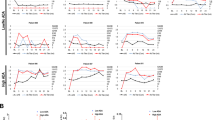Abstract
Purpose
For an outpatient cancer center to operate efficiently, optimizing the use of chair time is essential. Allogeneic hematopoietic cell transplant (allo-HCT) recipients are seen frequently in this setting after hospital discharge and regularly for several months thereafter. Aggressive electrolyte replacement is commonly required in these patients, primarily due to renal wasting with calcineurin inhibitor use. Frequent intravenous (IV) magnesium repletion, requiring several hours of infusion time, is often needed in these patients to adequately manage their magnesium deficiencies. The purpose of this study is to explore the impact of extending the infusion rate of intravenous magnesium sulfate on the frequency and degree of IV magnesium replacements required in allo-HCT recipients.
Methods
We conducted a retrospective study to compare two cohorts of patients administered IV magnesium sulfate at a rate of 4 g/1 h versus 4 g/2 h.
Results
A total of 103 continuous patients were assessed in two groups as cohort 1 at the 4 g/1 h rate and cohort 2 at the 4 g/2 h rate. Cohort 1 required less IV magnesium per outpatient visit (median 2.2 vs. 2.9 g/visit, P = 0.0211) and less total IV magnesium replacement through day +100 (median 68 vs. 85 g, P = 0.0479) than cohort 2.
Conclusion
These data suggest that there is no apparent benefit of prolonging magnesium infusion from 1 to 2 h in our outpatient allo-HCT population.
Similar content being viewed by others
References
Volpe SL (2013) Magnesium in disease prevention and overall health. Adv Nutr 4(3):378S–383S
Jahnen-Dechent W, Ketteler M (2012) Magnesium basics. Clin Kidney J 5(Suppl 1):i3–i14
Assadi F (2010) Hypomagnesemia: an evidence-based approach to clinical cases. Iran J Kidney Dis 4(1):13–19
Touyz RM (2004) Magnesium in clinical medicine. Front Biosci 9:1278–1293
Lee CH, Kim G (2007) Electrolyte and acid-base disturbances induced by calcineurin inhibitors. Electrolyte Blood Press 5(2):126–130
Gouadon E, Lecerf F, German-Fattal M (2012) Differential effects of cyclosporine A and tacrolimus on magnesium influx in Caco2 cells. J Pharm Sci 15(3):389–398
Aisa Y, Mori T, Nakazato T, Shimizu T, Yamazaki R, Ikeda Y et al (2005) Effects of immunosuppressive agents on magnesium metabolism early after allogeneic hematopoietic stem cell transplantation. Transplantation 80(8):1046–1050
Arthur JM, Shamim S (2000) Interaction of cyclosporine and FK506 with diuretics in transplant patient. Kidney Int 58:325–330
Lee JH, Choi SJ, Lee JH, Kim SE, Seol M, Lee YS et al (2005) Severe metabolic abnormalities after allogeneic hematopoietic cell transplantation. Bone Marrow Transplant 35(1):63–69
Oster JR, Epstein M (1988) Management of magnesium depletion. Am J Nephrol 8(5):349–354
Fawcett WJ, Haxby EJ, Male DA (1999) Magnesium: physiology and pharmacology. Br J Anaesth 83(2):302–320
Author information
Authors and Affiliations
Corresponding author
Ethics declarations
Conflict of interest
The authors declare that they have no conflict of interest.
Rights and permissions
About this article
Cite this article
Snyder, M., Shillingburg, A., Newton, M. et al. Impact of intravenous magnesium infusion rate during ambulatory replacements on serum magnesium concentrations after allogeneic stem cell transplant. Support Care Cancer 24, 4237–4240 (2016). https://doi.org/10.1007/s00520-016-3252-9
Received:
Accepted:
Published:
Issue Date:
DOI: https://doi.org/10.1007/s00520-016-3252-9




